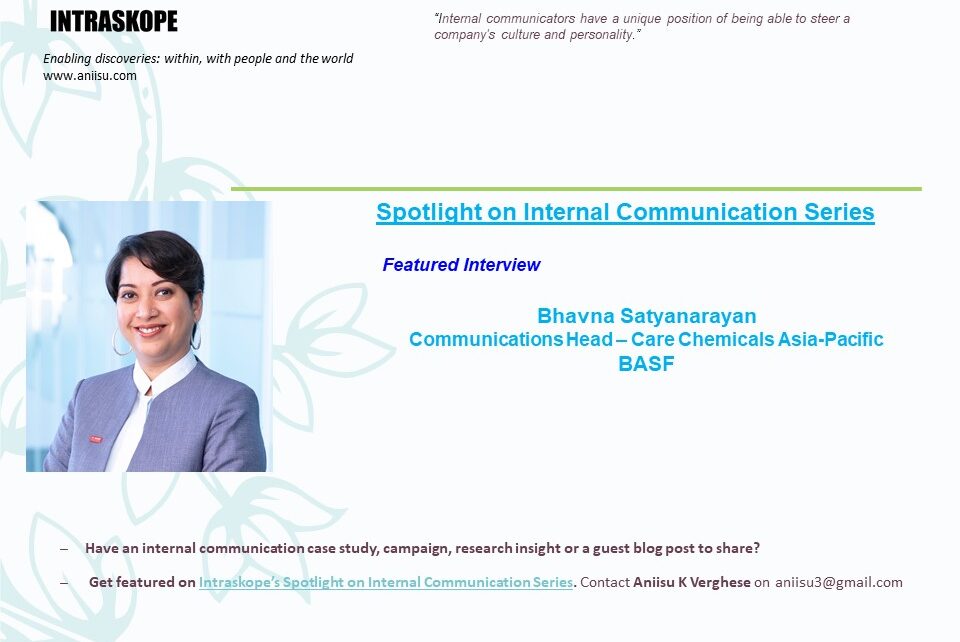Presenting the 38th edition of Intraskope’s Spotlight on Internal Communication Series featuringBhavna Satyanarayan. Watch the complete video interview on YouTube or read the transcript below. Bhavna is the Head of Communications at the Care Chemicals division of BASF Asia-Pacific based in Hong Kong. An experienced, outcome-driven, communications professional, she has worked on the agency and corporate sides in India and overseas. With a wealth of experience in various facets including corporate reputation management, crisis management, internal, digital, change and leadership communications she has helped blue-chip companies achieve their business goals. Learn more from her in this interview.
1. What does internal communication mean to you?
Internal communication is a very integral part of the DNA of an organization. How and what an organization and its leaders communicate with their employees regularly and on special topics and initiatives is the crux of what internal communication can and should steer.
2. How is it practiced in your organization?
Internal communication is (rightly) treated as a specialized field with tangible goals and activities. Colleagues in internal communications work closely with leaders and HR, as consultants, on many of the company-wide initiatives.
3. Please share an example/campaign that you are personally proud of working on and that made a significant impact to an organization in the recent past
I have led and been part of three (culture) change initiatives – two at my current organization and one at my previous one. I have been fortunate to have rolled this out at a country, region (Asia Pacific) and business unit level – all of which have given me a very good understanding of how differently it is perceived at various levels of the organization and in different contexts of job roles, country culture, etc. Culture change initiatives need to be handled with a lot of empathy, especially since they are top down usually. Making it resonate with most of the employee base, especially in a manufacturing set-up; getting people to commit to it and own it; and lastly instilling a sense of pride for working in the organization are all milestones in a culture program. I have seen it take its complete course in one of the rollouts and I am currently in the middle of another one.
4. What is the biggest challenge you face while going about managing internal communication?
To me, the biggest challenge is when the leadership does not believe in the power of communicating with the employees or if they lack belief in empowering communication among employees – this is a true reflection of how open an organization is and how much they value their workforce.
5. What according to you is the biggest opportunity that internal communicators have?
I go back here to what I mentioned here before – internal communicators have a unique position of being able to steer a company’s culture and personality.
6. How can internal communicators add more value to the business?
Many businesses these days are spread across locations, job junctions, time zones, etc. For e.g., in the business that I work for, we have close to 800 employees spread across Asia Pacific – from R&D to production. Connecting this employee base to break silos, inspiring them through stories and experiences, highlighting successes, enabling recognition and cascading the business’s (and leadership’s) goals and vision are some of the ways in which internal communications can add value.
7. What skills must they have or develop?
A good understanding of the employee base, cultural nuances, behaviors and employee reactions to various channels and mediums of communication and being able to think from an employee’s perspective – these are some of the skills which will help an internal communication expert go a long way in shaping programs that can make a difference.
8. What is your advice for people who are keen to join internal communication and make a career?
Internal communications is a specialization and has various facets to it. It is not about putting up a few posters of sending out some emails. It is a lot more than that. It is about bringing people together, creating a culture, cascading the vision, mission of a business/organization, instilling pride and a lot more. It is a science and involves a very critical aspect of any organization – its people.
9. What is your advice for women who want to make a mark in this domain and what must they do differently?
To be honest, I don’t think there is anything that a woman should do differently than a man in this job. Gender agnostically, an internal communicator should be able to think strategically as well as tactically, speak up and give the right advice to leadership and understand the different landscapes in which employees are based.
10. With COVID-19 and other crises, how must internal communications engage? What has changed or will change? Examples of how your organization has helped reassure employees and navigate the crisis as it unfolds.
The COVID-19 crisis like any other crisis has laid emphasis on how important it is to be clear, open, precise and quick while communicating with your employee base. Employees’ trust in an organization is based on this. In our organization, we had to align with different countries to see how the situation was unfolding there and communicate next steps accordingly. We had weekly updates (and in some cases more frequent communication as needed) on the working situation, what employees were meant to follow, health and hygiene tips, webinars focused on mental health, etc. We also had our leadership communicate via video messages very frequently, in order to reassure employees and keep their morale high. We had some small fun activities of sharing remote working stories, experiences about fulfilling customer expectation even in such a tough situation and of how employees were helping each other and the society. We also ran surveys to see how employees were feeling and what further support they needed to tide over this unprecedented crisis. A feeling of purpose and belonging is important in such situations and internal communications can be in the driver’s seat to create such an atmosphere.
11. Can you share one trend that you spot with internal communications?
Digitalization of mediums; less is more; informal and open communication from leaders.
12. If there is one aspect of internal communications you would like to change, what would that be?
Leaders believing that it is an add on function to administration or HR. Each function has a role to play and so does internal communications.
Liked the interview? Post your comments and share it with your network.
Keen to contribute and participate in the ongoing series on Intraskope where we put the spotlight on thought leadership, great ideas, and practical solutions? Look up the previous stories from organizations featured on the Intraskope’s Spotlight on Internal Communication Series here – Applied Materials India, Microsoft UK, Times Group, Samsung, Falabella, Brillio, UAE Exchange, Apeland, M.H. Alshaya Co, Proctor & Gamble, Infosys, SOBHA Ltd., ICICI Securities, First Advantage, CK Birla Group, TVS Motors, GE, Suzlon, Tata Sons, Percept, Knight Frank, TCS Europe, Vedanta, Oxfam, Danske Bank, Diageo, Pandora, Symantec, ISS Global Services, Telia, Thomson Reuters, IBM, General Motors, Intelligence India Software Solutions and Philips.
Intraskope (www.aniisu.com) is the first blog on internal communications in India and among the earliest around the globe. Begun in 2006, the blog has over 1000 posts on topics such as employee engagement, leadership communication and employee branding and receives thousands of visits from across the world. The blog, receives over 1,50,000 visits every month from over 50 countries globally, offers learning resources for practitioners, academicians, and students including industry workshops, research reports, and checklists.
Intraskope has been featured on leading global internal communication forums like Simply-Communicate, IC Kollectif and International Association of Business Communicators. It is hosted by Aniisu K Verghese, author of Internal Communications – Insights, Practices & Models (Sage, 2012).
If you are an internal communication leader working in a firm or a not-for-profit anywhere in the world and have an internal communication case study, campaign, research insight or a guest blog post to share please contact me on [email protected]
Here are Internal Communications resources you can use:
• Internal Communications Series: https://forms.gle/KcqmPzLwq7NQi5Km6
• Chat with Aniisu – Internal Communications: https://www.instamojo.com/intraskope/connect-with-aniisu-60-minute-personalized-d/?ref=store
• Internal Communications workshops: https://bit.ly/2zdBRl1
You can also visit my website www.intraskope.com and You Tube channel to know more about my work.



